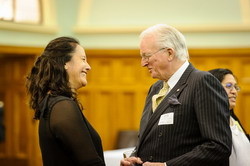Chair’s address at the HRC's 25th anniversary Parliament event, held on Tuesday, 17 November 2015, Grand Hall, Parliament
I would like to thank Minister Coleman and Minister Joyce for asking me to stay on as Chair of the Health Research Council until after the 25th Anniversary and to say a few words tonight. I would like to address the future given the past of the HRC has well and truly examined.
Minister Joyce gave a speech to the Royal Society dinner last week, but went on to say how impressed he was as he had seen a dog’s jaw bone that had been created on a 3D printer.
This set me thinking about comparing the past 4 years as HRC Chairman and the last 4 years of SKOPE Industries, a Christchurch manufacturing company designing world leading low energy commercial refrigerators for companies like Coca-Cola, Schweppes, Frucor, etc.
SKOPE needed to design and build a completely new generation of refrigeration in an effort to compete in the vicious and unrelenting competitive world it operates in, where at least four manufacturers in China and other countries copy its designs exactly.
With the help of a Callaghan Grant, my wife and I agreed, as the owners, to a research and development project employing 20 engineers. Although three times larger in dollar terms than the largest HRC grant, the research process is remarkably similar, given the goal is known but a successful outcome is not.
The initial prototype of what we now call ‘the Active Core’ was made in a sterile room in China on a 3D printer, in plastic. The parts were put together in Christchurch so that serious testing could be done in our world-class environmental chamber. This million dollar-plus room was formally opened by Minister Joyce in 2012. When all the testing was finished, the very large plastic parts were made in steel assembly tooling and plastic moulding dies in China.
If you are getting the similarity of the process I have to tell you the comparison starts to diverge.
Half way through the process in great secret SKOPE started spending serious money on protecting the intellectual property, the products name and other aspects of the new product in several countries.
My deep concern is that although in the 12 years or so I have been involved in medical research and watched researchers “give away” their findings arguing they were put on this earth for the greater good of mankind to where a reward would be nice, but recognition of their efforts is still a priority, there is still much to do to convince brilliant researchers that legally protecting their work before publishing is essential when they are spending taxpayers money.
This needs to be resolved and the documentation, or contract modification between the HRC funders and research parties needs to be changed to capture this outcome.
The signing of the new Free Trade Treaty, ‘TPPA’, may strengthen the monetary value of successful medical research in New Zealand and this needs to be researched.
The introduction in the past 3 years of joint venture research funding between the HRC and not-for-profit organisations, such as Breast Cancer, Cure Kids and others, turning taxpayer HRC-funded $5 million into a joint venture $10 million, could be doubled easily with additional focus taxpayer funding.
No country can fund its population’s health with taxpayer funds alone. Research is the only way it can stay on top of the heavy responsibility of keeping the population healthy. The HRC has proven it is the best organisation to purchase this research.
A new type of medical doctor is required to cope with the future in addition to the present excellent medical practise doctors. Medical doctors with business, law and commerce degrees will make our DHBs more effective long term and engineering, electronics medical degrees will produce world-leading manufactured products such as an artificial pancreas, or diabetic insulin pumps.
New Zealand is the only country left that does not provide graduate entry training of doctors that qualify under the Edinburg System.
Looking back when Sir Don Bevan and I worked to introduce the ability of brilliant engineers having a credit for their degree so they could become a medical doctor and make ‘state of the art’ medical products in Canterbury, we were ahead of our time perhaps. The then Finance Minister, Dr Michael Cullen, made it clear graduate entry medical doctor training would never happen because of the perceived financial hurt to the city of Dunedin and it hasn’t to this day.
In my view, New Zealand needs to compete in the real world now emerging and must keep up in this critical area which will bring a real increase of wealth based on medical research.
Finally, the serious medical research investment that a number of countries are making to be a core wealth contributor in their future, particularly China and Australia, will mean that those countries will work hard to take our best and brightest teams to their countries.
If these scientists leave New Zealand with their intellectual property and value funded by the HRC they should pay those funds back to the HRC.
I would like to thank the Board and the Secretariat of the HRC for giving me the opportunity for putting some of my accumulated knowledge back into a most worthwhile organisation and I look forward to watching the HRC going forward from strength to strength into the future.
Sir Robert Stewart, KNZM
Chair
